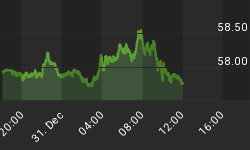This was a deeply significant week in the global monetary system. For the last 40 years the developed world has insisted that currencies are the definitive money and that gold -- and silver too -- is a 'barbarous relic'. Reflect on currency and national debt management over the last four years and the decade of blithe confidence before that. The smart money went into gold during this time and has multiplied six times in a decade.
The announcements by both the Bank of Japan and the Swiss National Bank that they were to weaken their currencies means neither the Swiss Franc nor the Japanese Yen are 'safe havens' against a falling U.S. dollar and Euro. Furthermore, these actions are an indictment of the system of currencies as alternatives to other currencies.
This elevates gold and silver as 'counters to currencies'.
This consequence has arisen because of the, now clear, failure of the U.S. Congress to rein in spending sufficiently, or to raise taxes, in a manner able to rein in the U.S. deficit. The spending cuts over the next decade [most after 2017] will cut spending ½% of GDP. The deficit stands at 10% of GDP. This is detrimental to the dollar as the global reserve currency.
Currencies as Money
When President Nixon cut the dollar loose for gold he and subsequent governments held the dollar up as the only real money, with other currencies following the same path. Prior to that, civilizations going back thousands of years accepted only gold-backed money. Gold was real money then, with notes drawn on the gold they represented. It was that link that defined it as money.
What was not flagged when Nixon cut the link to gold was the reality that governments replaced gold as the backing for money notes. Previously you could present your dollar for a dollar's worth of gold and you got it; foreign governments could do the same. After the gold window was closed, whenever you presented your dollar you received another paper dollar. Remarkably the trick worked. Add to that a 30-year long campaign to discredit gold as money through central bank and accelerated gold sales and you left everybody with no alternative to paper money. For 40 years the experiment worked well with everybody convinced that at the heart of the new monetary system was the U.S. dollar, based on the soundness of the U.S. economy and global influence. The link to oil ensured it was the prime means of exchange used globally for basic energy needs, ensuring its indispensability.
Its success was so great that instead of gold pricing paper money, paper money priced gold.
Instead of $42 equaling an ounce of gold, an ounce of gold equaled $42.
That's why today we ask the price of gold in the dollar not the price of the dollar in gold.
But the only way this system could work well and permanently, was for it to sustain its value on a steady, unflinching, immoveable path. This meant that everything should be measurable against it, constantly and reliably. Unfortunately governments are made up of politicians who belong to different parties. They represent a nation that has a variable budget and a tendency to be crowd-pleasers. Their role is to give the people what they want, and people's wants are often not consistent with a steady, constant measure of value. Structurally, these two concepts clash. Therefore, experiment had a time limit from the very beginning.
In the past, the central bank of a nation has been charged with ensuring that a nation's money does provide price stability, but that is not the same as a measure of value. Presently, central banks see themselves as encouraging growth, jobs, and a variable supply of money to back up, but not be responsible for the state of a nation's economy. This turns paper money into a changeable item of varying value.
Take for instance the dollar and the euro at the time of the euro's inception. They were at a value of 1:1. Today, they are at a value of €1: $1.43, a decline in exchange rate value of 43 cents. Both the Euro and the USD have fallen in value against other strong currencies such as the Yen and the Swiss Franc. Many investors hoped that the Swiss Franc and the Yen would act as true measures of value when the USD and the Euro failed. Presently that fallacy revealed itself again as the nation's central banks act to weaken the value of their currencies through their printing machines. This is the only way an economy's global competitive position can be protected. But the cost is the loss of ability by the national currency to provide value. More than that, the action this week, by the B of J and the SNB confirmed that the strongest global currencies will not allow themselves to be reliable measures of value.
The net result: we have to face the stark reality that the currency system we now live under globally cannot provide a true measure of value.
Gold Sales Will No Longer Work
A global measure of value can only be provided by something that cannot be manipulated by a government, for whatever reason. Furthermore, it must be something that cannot be managed by a single, or even several governments as was the case from 1971 until central banks gold sales stopped in around 2009. The condition that has arrived is that, if one government tried to manipulate the price down, another government would buy the gold put on sale. This would prevent a repeat of the central banks' gold sales programs of the last 35 years. With every government wanting to hold the gold or buy more, we now have a global consensus that gold is a vital reserve asset, the way it was before 1971.
The path back to money has to be taken, so what will it entail?
The Return of Gold as Money
For Subscribers Only
GoldForecaster.com SilverForecaster.com
















